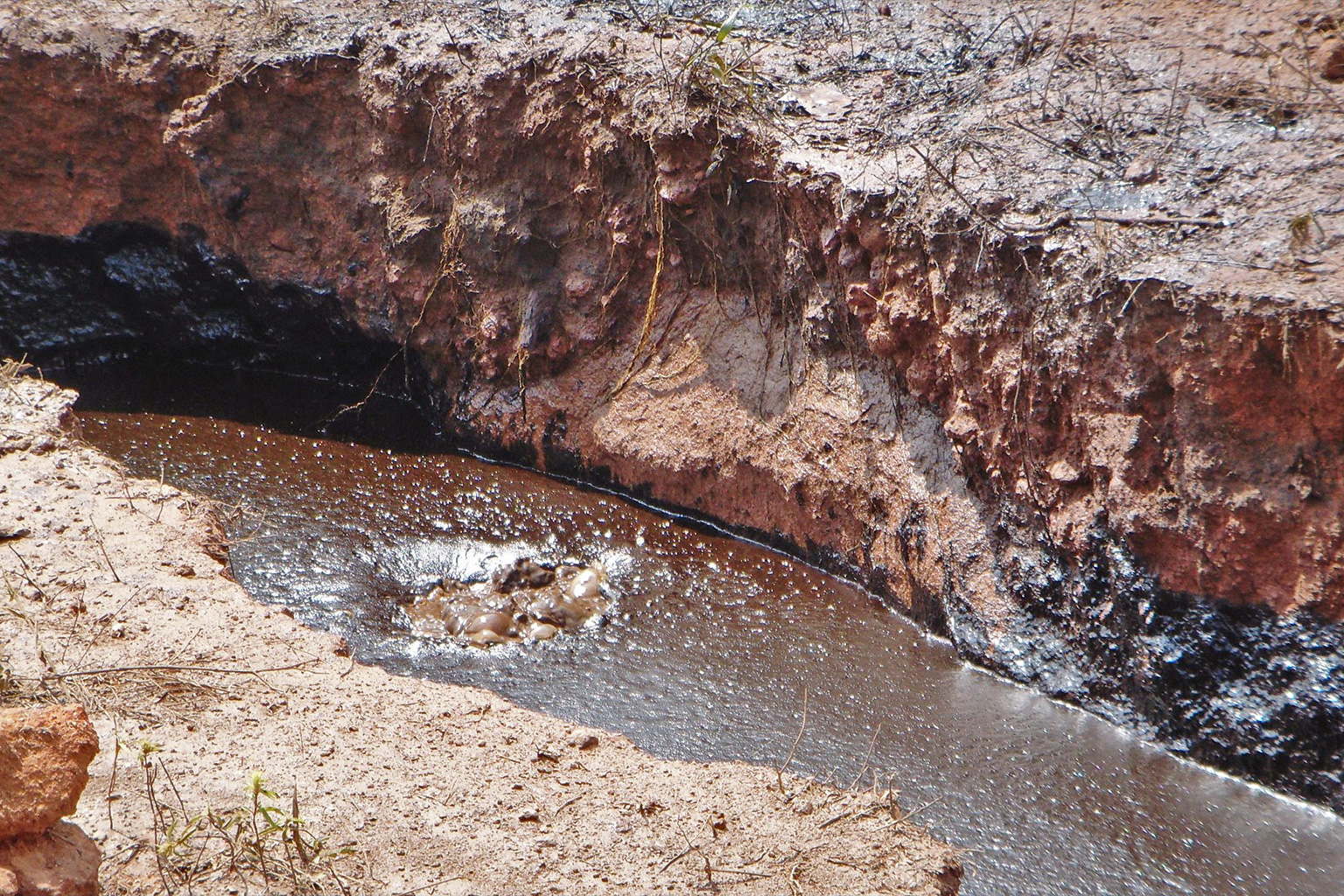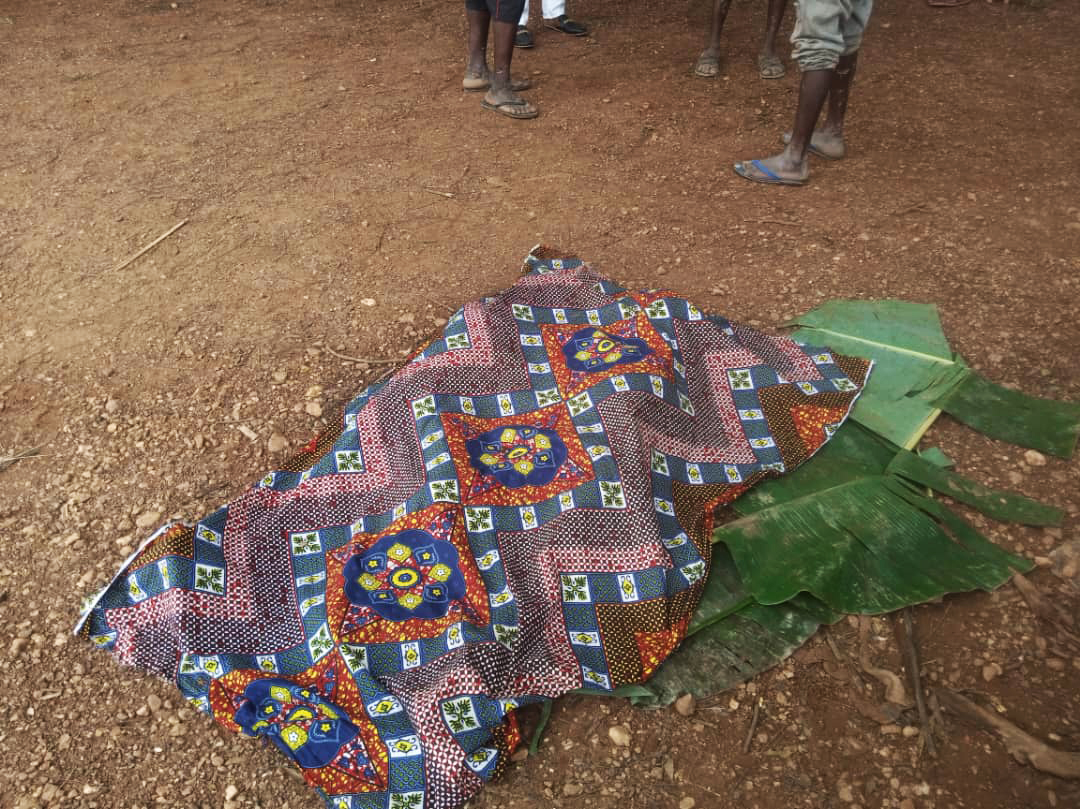A report by Human Rights Watch based on interviews with displaced families says an oil pipeline running from Uganda to Tanzania will be disastrous for the people in its path.Farms and streams in southern Chad have been contaminated after another spill at an oil installation owned by Anglo-French oil player Perenco.Three boys have drowned in a rain-filled mining pit in Ghana, highlighting the dangers that thousands of these pits, abandoned by illegal gold miners, pose to nearby communities.Element Africa is Mongabay’s bi-weekly bulletin rounding up brief stories from the commodities industry in Africa. TotalEnergies’ East African pipeline a ‘disaster’ for local communities
The oil pipeline being built by French oil major TotalEnergies from Uganda’s Alberrtine Rift to the port of Tanga in Tanzania is a “disaster” for people living along its route, according to a report based on interviews with 75 affected families affected by its construction and the organisation has now published a report describing the East African Crude Oil Pipeline (EACOP) as a “disaster” for people living along its route.
The project’s owners say the East African Crude Oil Pipeline (EACOP) and the Tilenga oil field that it serves will improve the living conditions of those affected by the project, and boast that compensation agreements have been reached with almost all families who will be displaced. But interviews by Human Rights Watch paint a different picture. Farmers were paid, the group’s report says, but not fairly. Because they had to wait between three and five years to be compensated, many went into debt to meet their daily expenses.
“Before our land was taken for the CPF [central processing facility at Tilenga], we used to grow cassava, groundnuts, and maize. This is what I grew my 11 children and my 30 grandchildren on. Now that land is all gone,” one 79-year old woman, who lost 2.2 hectares (5.5 acres), told HRW interviewers. Other affected families said their compensation wouldn’t be enough to clear these debts.
Road construction for the pipeline near Uganda’s Murchison National Park: machinery and heavy trucks within the park boundaries have disturbed wildlife. Image by Thomas Lewton.
The HRW report is the latest in a series that have made damaging findings about the pipeline’s construction, noting failure to secure free, prior and informed consent from people who were in many cases asked to sign agreements that they couldn’t read. Last year, the European Parliament pinpointed human rights “violations” against opponents of the project. In June, 26 Ugandans and five French associations launched a legal action in France to demand payment from TotalEnergies to compensate for the damage the NGOs allege its oil project has caused.
In addition to the displacing communities along its 1,440-kilometer (900-mile) route and endangering forests, grasslands, rivers and wetlands along its route to the Indian Ocean, the pipeline will emit 379 million metric tons of CO2 over its lifetime, according to the Climate Accountability Institute. That’s more than the annual emissions of Australia, one of the world’s most polluting countries.
Farms, streams contaminated by spill at Perenco oil site in Chad
BADILA, Chad — A month after an oil spill in southern Chad, neither site operator PetroChad Mangara nor Perenco, owner of the Badila field where the incident occurred, have disclosed the causes.
On June 20, local journalist Hamama, who only uses one name, witnessed black liquid flowing freely through drainage pipes leading from the oil field at Badila into streams and farmland in this part of Chad.
Moussa Adoulaye, a resident of Badila, said local people can no longer work in their fields. “The crude oil spill is polluting the land, and we no longer have anything to eat. And if we enter our fields flooded with crude oil, wounds appear on our skins.”
He demanded compensation from the owner of the facility.
 A minor spill during construction of oil facilities in southern Chad in 2012. While that event was quickly cleaned up, neither the government nor the oil field operator has responded to questions about containing or rehabilitating damage caused by the most recent spill at Badila. Image by Ken Doerr via Flickr (CC BY 2.0).
A minor spill during construction of oil facilities in southern Chad in 2012. While that event was quickly cleaned up, neither the government nor the oil field operator has responded to questions about containing or rehabilitating damage caused by the most recent spill at Badila. Image by Ken Doerr via Flickr (CC BY 2.0).
But there’s been little in the way of an official response. Perenco, an Anglo-French company with interests across Central Africa, declined to comment. According to online news site Africa Press, the environment minister of Chad, Mahmat Abdelkarim Hanno, “noted” the Badila spill on June 23, but attempts to reach Edouard Tekadji, press attaché at the Ministry of the Environment and Fisheries, for comment were unsuccessful.
This is not the first significant spill in the Badila field. In September 2018, 85 million liters (22 million gallons) of contaminated water escaped from a wastewater containment basin. In the weeks that followed, around 50 people reported skin irritations, diarrhea and illness after drinking contaminated river water or using it to bathe. Livestock drinking water from the river also died, according to local reports.
Abandoned mining pit claims three more lives in Ghana
Three children died while swimming in an abandoned mining pit near the Offin River in Ghana’s Ashanti region, one of thousands of such sites peppered across the gold-rich regions of the country.
According to residents of Atwima Mponua district, children regularly swam in this and other water-filled pits. On July 2, three boys, two aged 6 and one aged 5, got into difficulty in a pit locals estimate is more than 3 meters (10 feet) deep. Two drowned at the site while the third managed to reach the shore; he died by the time he was brought to a hospital.
 An abandoned mine pit filled with rainwater in Atwima Mponua. Ghana’s gold-rich Ashanti Region is riddled with hazardous abandoned mine sites like this. Image by Ben Kwarteng.
An abandoned mine pit filled with rainwater in Atwima Mponua. Ghana’s gold-rich Ashanti Region is riddled with hazardous abandoned mine sites like this. Image by Ben Kwarteng.
Opayin Kokokuom Boah, the uncle of one of the boys, said the three had left the house that day in search of snails to eat. “Later we heard that three boys have drowned in a galamsey pit and my nephew was one of them,” he told Mongabay.
“This is not the first time we are experiencing this. It happens every year. Sometimes we record one or more deaths. Some are able to survive, others are not.”
He said the community had complained to the district assembly about the dangers of disused pits, but nothing has been done.
Galamsey, as illegal miners are popularly known in Ghana, typically abandon mine sites once they’re exhausted. Over time, the pits left behind fill with water, posing a threat to the health and safety of surrounding communities. In 2021, the government launched a land reclamation project to rehabilitate sites left behind by illegal miners, but this has so far had limited effect on the damaged landscapes of the country’s gold-producing regions.
 The covered body of one of the three drowned boys. Image by Ben Kwarteng.
The covered body of one of the three drowned boys. Image by Ben Kwarteng.
Christophe Nyemeck Beat, Elodie Toto, and Mabel Annang Adorkor contributed to this bulletin.
Banner image: Pipeline construction in progress in Uganda. Image courtesy of Thomas Lewton.
FEEDBACK: Use this form to send a message to the author of this post. If you want to post a public comment, you can do that at the bottom of the page.
Business, Corporations, Environment, environmental justice, Environmental Law, Governance, Human Rights, Illegal Mining, Industry, Land Rights, Mining, Oil, Oil Spills, Pollution
Africa, Central Africa, Chad, East Africa, Ghana, Sub-Saharan Africa, Uganda, West Africa
Source link : https://news.mongabay.com/2023/07/element-africa-a-disaster-pipeline-an-oil-field-spill-and-a-mining-pit-tragedy/
Author :
Publish date : 2023-07-19 07:00:00
Copyright for syndicated content belongs to the linked Source.





